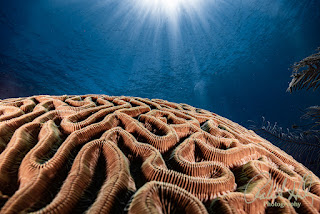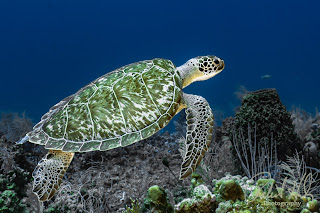Creating a Signature Editing Style for Your Underwater Photography Brand
A guide to developing a unique, recognizable editing style using Lightroom’s latest tools.
Creating a Signature Editing Style for Your Underwater
Photography Brand
How to Stand Out in a Sea of Blue Using Lightroom’s Latest Tools
When you scroll through your social media feeds, do you instantly recognize a photographer’s work even before seeing their name? This phenomenon is a testament to the remarkable power of a signature editing style. For underwater photographers, cultivating a distinctive visual identity goes beyond mere artistic expression. It is essential for making their images stand out in an ever-crowded digital landscape. A well-defined style helps reinforce your brand and plays a crucial role in transforming casual viewers into dedicated followers. This journey of establishing a unique editing style can engage your audience on a deeper level, allowing them to feel an emotional connection to your work. It makes your artistry memorable and can significantly enhance your presence and influence in the highly competitive world of underwater photography.
In this blog, I’ll walk you through how to build a
consistent, recognizable editing style using the latest tools in Adobe
Lightroom Classic. Whether you're editing coral reefs in Roatán or macro life
in muck dives, we’ll cover how to stay consistent and creative, without drowning
in a sea of sliders.
Why a Signature Style Matters
A signature style:
- Builds
recognition across platforms
- Establishes
trust and professionalism
- Makes
editing faster through repeatable workflows
- Becomes
your visual fingerprint
Step 1: Define Your Visual Identity
Start by answering:
- What
feelings do you want your images to evoke? (Adventure? Serenity? Mystery?)
- Do you
favor vibrant, saturated colors or muted tones?
- Are
your subjects crisply detailed, softly dreamy, or moody and contrasty?
For example, my style leans toward true-to-life color
accuracy with a pop of contrast and clarity, especially important in
blue-water environments where colors can flatten quickly.
Step 2: Use Lightroom Presets as Your Foundation
Presets help maintain consistency and speed across shoots.
Create Your Own Preset:
- Edit a
photo to match your ideal style.
- Click the + in the Presets Panel in the Develop Module,
then select “Create Preset”.
- Name
it something straightforward, like Bluewater Clarity Pop or Macro Glow
Boost.
- Check
the boxes for settings you want included (e.g., White Balance, Tone Curve,
Presence).
- Click Create.
🧠 Pro Tip: Keep
presets adaptable. Avoid locking in Exposure or White Balance unless you shoot
in entirely consistent lighting.
Step 3: Use Color Grading to Establish Mood
Lightroom’s Color Grading panel (formerly Split
Toning) lets you independently tone shadows, midtones, and highlights.
Example 1: Creating a Warm-Hued Macro Look
- Go to Color
Grading.
- To complement subjects like yellow frogfish, add subtle warm tones (Hue ~40, Sat ~10) to midtones.
- Cool
the shadows slightly (Hue ~220, Sat ~15) to contrast with the warm focus.
🎯 Shortcut: Press Shift
+ Cmd/Ctrl + 5 to jump to Color Grading panel.
Step 4: Customize AI-Powered Masking for Local
Enhancements
Lightroom’s latest AI masking tools let you selectively
enhance your subject without touching the background.
Example 2: Bring a Nudibranch to Life
- Click Masking
> Select Subject (Lightroom AI will detect the nudibranch).
- Use texture, clarity, and sharpening to enhance the skin's detail.
- Texture:
+25
- Clarity:
+15
- Sharpening:
+40
- Add a
second mask for the Background using Select Background.
- Lower
Exposure slightly (-0.3) and Dehaze (-5) to make your subject pop.
🎯 Shortcut: Press Shift
+ W to open Masking Panel.
Step 5: Leverage the Tone Curve for Depth
The Tone Curve allows for subtle contrast and punch
without blowing out highlights.
Example 3: Creating Contrast in Blue Water Wide Angles
- Add an
“S” curve:
- Lift
the shadows slightly
- Pull
down the darks (dark shades)
- Push
the midtones up
- Slight
lift on highlights
- This
gives that signature depth without oversaturating your blues.
🎯 Shortcut: Click
on the Tone Curve panel or press Shift + Cmd/Ctrl + 2.
Step 6: Create a Consistent Crop & Aspect Ratio
Stick to one or two aspect ratios, such as 4x5 for Instagram
or 16:9 for web banners. This keeps your portfolio clean and cohesive.
Example 4: Standardizing Crop for Social Media
- Use
the Crop Tool (press R) and set Aspect Ratio to 4x5.
- Position
your subject using the Rule of Thirds or Golden Ratio Overlay
(press O to cycle overlays).
Step 7: Develop a Color Palette
Use the HSL/Color panel to gently nudge tones toward
a signature look.
Example 5: Harmonizing Reds and Blues in Coral Reefs
- Increase the Luminance of Reds to lift coral brightness.
- Slightly
desaturate Aqua (-10) to avoid overbearing cyan tones.
- Adjust
Blue Hue toward a deeper blue (-10) for ocean backgrounds.
🎯 Shortcut: Press Cmd/Ctrl
+ 3 to open the HSL Panel.
Step 8: Save Edits as a Custom Template or Apply Across
Collections
Once you're happy with your style:
- Sync
settings across similar photos using Cmd/Ctrl + Shift + S.
- Save
as a Preset for future use.
- Or
save the entire layout as a Develop Preset Group to keep consistent
collections organized.
Bonus: Keep an Inspiration Collection
Start a Collection Set titled Style Inspo
where you save 5–10 of your favorite self-edits that reflect your brand.
Revisit this as a benchmark when you're tempted to stray.
Final Thoughts
Developing a distinctive signature editing style is not a simple task that can be achieved with just one click. It is a gradual process that unfolds over time. Begin with a clear vision of what you want to achieve, and utilize Lightroom's powerful AI features and comprehensive manual tools. With dedication and practice, you will soon cultivate a recognizable aesthetic that distinguishes your underwater photography from others in the field.
It's important to remember that having a signature style does not equate to uniformity. Instead, it embodies cohesion among your images. Allow each photograph to shine brightly, yet ensure they communicate a unified message and reflect your unique voice as a photographer.
📌 Stay consistent. Stay creative. And dive deep—your style is waiting.
- 💡 Read more Lightroom tips at RobertHerb.blogspot.com.
- 💡 Get weekly updates when new blogs are published at: https://info.robertherb.com/lm-2-blog
- 💡 Join my upcoming online training program – Learn to enhance your underwater shots with Adobe Lightroom! Sign up for a FREE "Before & After" Gallery.
- 💡 Share your processed photos on social media using #RobertHerbPhotography.
- 💡 Questions or want help with your Lightroom workflow? Email me at bob@robertherb.com
Written by Robert Herb – Empowering underwater photographers to capture and enhance the beauty of our oceans.
Stay tuned for more in-depth insights into underwater photography. Let’s dive deeper into the art and craft of capturing the marine world! If you have any comments or suggestions, I’d love to hear them.
Get ready for an exciting underwater photography adventure! For more details on my upcoming online training course, check out my "Training" page at RobertHerb.com or email me at bob@robertherb.com.
Sincerely,
Bob Herb
|
|





Comments
Post a Comment
Please let me know your comments.